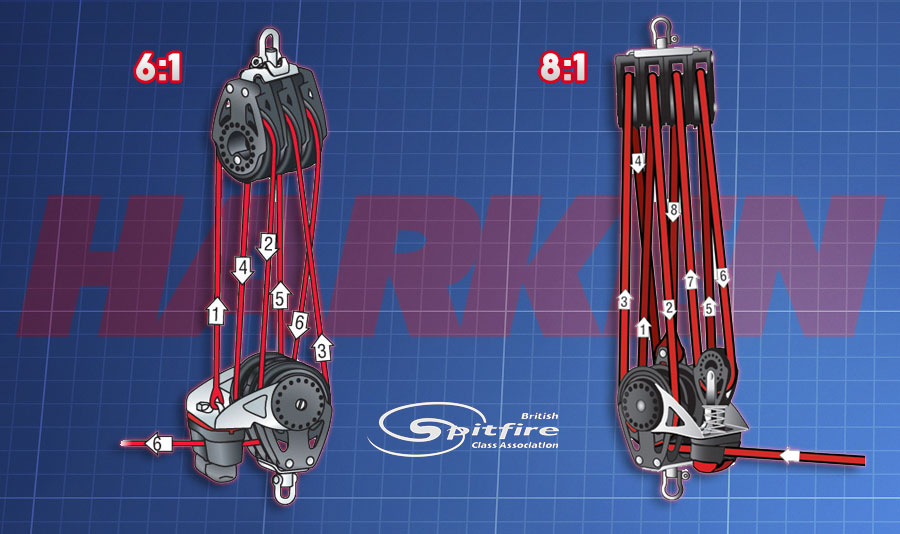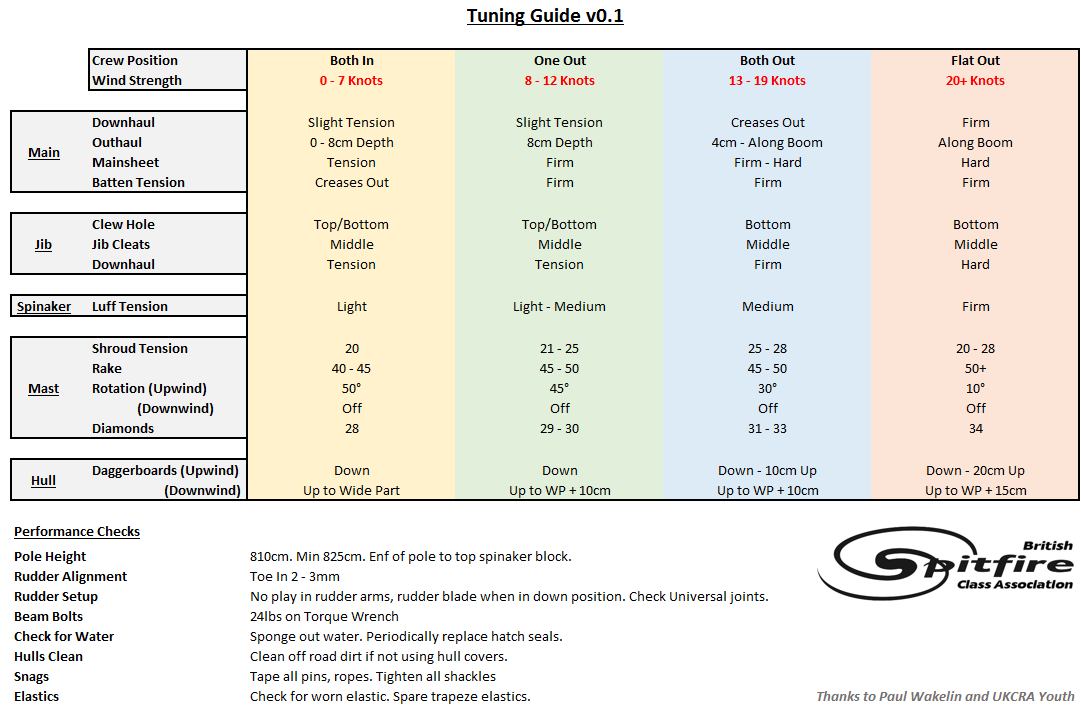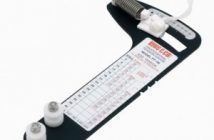Being one of the main controls when sailing the main sheet is a crucial component in getting the power out of your main. But as with all things there are several ways of improving it. First of all we should take a look at the class rules and some of the changes that were made at the 2015 AGM.
2.9 Mainsail Rigging
2.9.1 The basic configuration of the mainsheet system shall not be altered from that provided by WF, with the lower block attached to the traveller car via a shackle, and the upper block attached to the boom via a strop.
2.9.2 An additional single block may be attached to the lower mainsheet block to increase the purchase of the mainsheet. The purchase of the complete mainsheet system when modified in this way shall not exceed 7:1.
2.9.3 Alternatively, the mainsheet blocks may be replaced with ones having 4 sheaves at the top and 3+1 sheaves + becket at the bottom. The diameter of
the sheaves shall not exceed the original blocks (max 57mm for the main sheaves). The purchase of the complete mainsheet system shall not exceed 8:1.
2.9.4 The separate traveller line and mainsheet may be replaced with a single line.
2.9.5 The mainsheet may be attached to the upper block by any means.
2.9.6 The traveller (or traveller end of the mainsheet if a single line is used) may be attached to the rear beam eye-straps by any means.
Ratios
The basic configuration of the mainsheet system as supplied by White Formula is a 6:1 system as pictured. A change made at the 2015 AGM allows the main sheet to be upgraded to a maximum of 8:1 which will benefit youth teams who have joined the class. A 7:1 system can be made using the extra block picture on the 8:1 system but on the 6:1 system with the sheet tied through the centre of the upper blocks.
There are of course advantages and disadvantages of each system. The higher the ratio the easier it is going to be to crank on the tension however youre also going to end up with a lot of sheet lying around the boat in order to be able to let the main out fully. Its personal preference however a good 7:1 system seems to be a good balance between being responsive and easy to crank on when the breeze comes through.
Parts
For those wishing to purchase the parts to make either system the Harken parts are listed below. Big thanks to Harken who supply a discount to UKCRA Youth teams making this upgrade much more accessible.
- 6:1 Parts: Upper Block, Lower Block
- 8:1 Parts: Upper Block, Lower Block, 38mm Saddle, 40mm Block (Or only Upper Block and Ratchamatic Carbo Lower Block)
- 7:1 Upgrade: 38mm Saddle, 40mm Block
The difference between the lower blocks available are Ratchet or Ratchamatic. After a discussion between a few members it was felt that it is best to use the ratchet lower block in favour of Ratchamatic due to there not being a need for the mainsheet to run freely. Even in light winds a good mainsheet will not be able to slip past the ratchet when the helm releases the tension. Auto Ratchet systems are traditionally more susceptible to sand and grit interfering resulting in a loss of ratchet.
Mainsheet Ropes
The rope used for the mainsheet in the spitfire fleet vary and there are some real trick pieces out there with tapered ends and extracted cores. If we look at the Spitfire Ropes, Lines and Ties List we can find the length and recommended diameter.
Item |
Recommended Material |
Example Product |
Min Diameter (mm) |
Recommended Length (m) |
| Main Sheet | Dyneema/Polester Rope | Maffioli Swiftcord | 8 | 8 (6:1) |
| Main Sheet Strop | Dyneema Core Rope | Marlow Excel Race | 6 | 1 |
| Traveller Control | Sheet Rope | Marlow Excel Pro/Kingfisher Evo Sheet | 8 | 2.5 |
It may be a good idea to put an additional knot in either end of the mainsheet. This stops the whole system unravelling if the block end or crew end of the mainsheet becomes undone.
Traveller
The traveller rope can be a continuation of the mainsheet however it is often useful to keep the two separate and different in colour for the inevitable moment when letting the mainsheet out isn’t enough and the helm needs to dump the traveller. Another good reason to keep them separate is the ability to replace the ropes individually when the area around the cleats becomes worn and also being able to easily remove the mainsheet when packing the boat away. A Reef Knot or Sheet Bend is not good enough to connect the two ropes and from experience they will come undone at the most critical point of the race. Personally I would use a Double Fishersmans Bend and add some tape over the tails just in case.
The traveller tied to a single point on a rear beam does not bring the traveller carriage to a central position and will often sit a few inches away from the centre. In order to bring this into a central position the traveller must be tied to two saddles either side of the mid point. This requires the inner and outer core of the traveller rope to be split and whipped so that one part can be tied to each saddle.
Tie a knot in the traveller in order to stop the carriage hitting the end of the track. This stops or softens the blown of the traveller carriage hitting the bolts at the end of the track which has previously resulted in dismounted traveller carriages.
Strop
The strop allows for a range of adjustability. It can be lengthened or shortened to take up mainsheet if you feel its too short or long. When the main is pinned in tight the blocks should be almost block to block. Its a good idea not to design your system to go block to block as ropes and sails may stretch which means that after some time you may get block to block too easily.
We have seen plent of strops with clips, shackles or even ones which are simply tied. The strop should always go through the middle of the three holes in the plate at the back of the main. The best system has to be dyneema with a tightening loop on one end and a bobble on the other. The loop can be passed through the sail and over the bobble and then tighten to be certain it isnt going to come off. This avoids adding shackles, clips and other bits of metal to a part of the boat which often whips the helm in the face. However you design it in the case of squalls you want to be able to quickly remove your mainsheet as quickly as possible once you return to shore. If it takes longer than 5 seconds then definitely make a change.
Key Points
- Make a mainsheet, traveller and strop that works for you.
- Tighten all shackles and knots when setting up
- Check it all again before going afloat.
- Carry Spare Shackles just in case.
- Remove your mainsheet over night at events when storing the boat or be prepared to say goodbye to £300 worth of kit!





2 Comments
Will Smith, Megan Smith and Stewart Smith have tried the 8:1 and like it. We also use F18 Fairlead Spacers on the Mainsheet cleat, part number H-40229A with longer bolts.
Pingback: 2015 Spitfire Inland Championships – Grafham Cat Open | British Spitfire Class Association